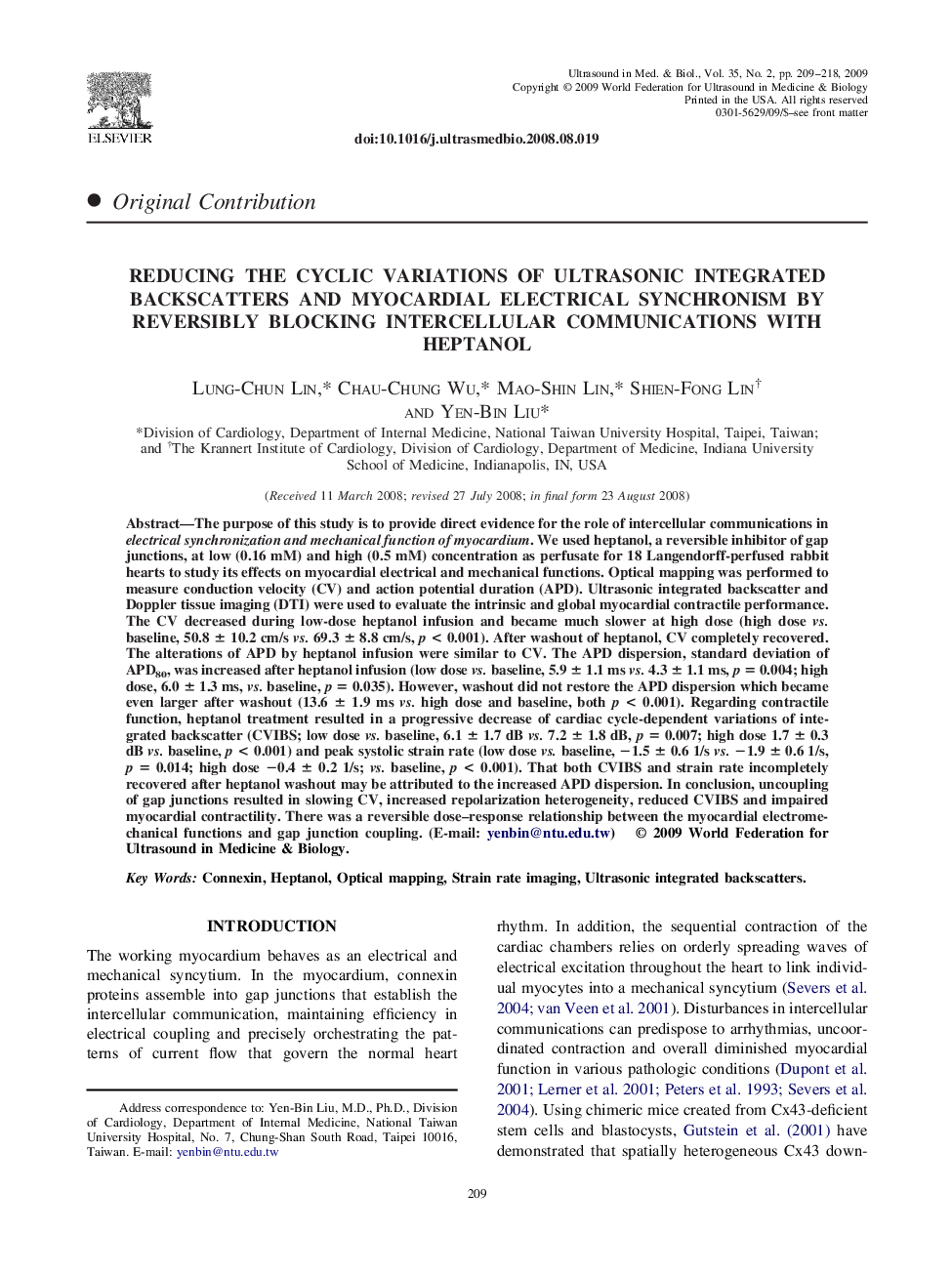| کد مقاله | کد نشریه | سال انتشار | مقاله انگلیسی | نسخه تمام متن |
|---|---|---|---|---|
| 1761512 | 1019651 | 2009 | 10 صفحه PDF | دانلود رایگان |
عنوان انگلیسی مقاله ISI
Reducing the Cyclic Variations of Ultrasonic Integrated Backscatters and Myocardial Electrical Synchronism by Reversibly Blocking Intercellular Communications with Heptanol
دانلود مقاله + سفارش ترجمه
دانلود مقاله ISI انگلیسی
رایگان برای ایرانیان
کلمات کلیدی
موضوعات مرتبط
مهندسی و علوم پایه
فیزیک و نجوم
آکوستیک و فرا صوت
پیش نمایش صفحه اول مقاله

چکیده انگلیسی
The purpose of this study is to provide direct evidence for the role of intercellular communications in electrical synchronization and mechanical function of myocardium. We used heptanol, a reversible inhibitor of gap junctions, at low (0.16 mM) and high (0.5 mM) concentration as perfusate for 18 Langendorff-perfused rabbit hearts to study its effects on myocardial electrical and mechanical functions. Optical mapping was performed to measure conduction velocity (CV) and action potential duration (APD). Ultrasonic integrated backscatter and Doppler tissue imaging (DTI) were used to evaluate the intrinsic and global myocardial contractile performance. The CV decreased during low-dose heptanol infusion and became much slower at high dose (high dose vs. baseline, 50.8 ± 10.2 cm/s vs. 69.3 ± 8.8 cm/s, p < 0.001). After washout of heptanol, CV completely recovered. The alterations of APD by heptanol infusion were similar to CV. The APD dispersion, standard deviation of APD80, was increased after heptanol infusion (low dose vs. baseline, 5.9 ± 1.1 ms vs. 4.3 ± 1.1 ms, p = 0.004; high dose, 6.0 ± 1.3 ms, vs. baseline, p = 0.035). However, washout did not restore the APD dispersion which became even larger after washout (13.6 ± 1.9 ms vs. high dose and baseline, both p < 0.001). Regarding contractile function, heptanol treatment resulted in a progressive decrease of cardiac cycle-dependent variations of integrated backscatter (CVIBS; low dose vs. baseline, 6.1 ± 1.7 dB vs. 7.2 ± 1.8 dB, p = 0.007; high dose 1.7 ± 0.3 dB vs. baseline, p < 0.001) and peak systolic strain rate (low dose vs. baseline, â1.5 ± 0.6 1/s vs. â1.9 ± 0.6 1/s, p = 0.014; high dose â0.4 ± 0.2 1/s; vs. baseline, p < 0.001). That both CVIBS and strain rate incompletely recovered after heptanol washout may be attributed to the increased APD dispersion. In conclusion, uncoupling of gap junctions resulted in slowing CV, increased repolarization heterogeneity, reduced CVIBS and impaired myocardial contractility. There was a reversible dose-response relationship between the myocardial electromechanical functions and gap junction coupling. (E-mail: yenbin@ntu.edu.tw)
ناشر
Database: Elsevier - ScienceDirect (ساینس دایرکت)
Journal: Ultrasound in Medicine & Biology - Volume 35, Issue 2, February 2009, Pages 209-218
Journal: Ultrasound in Medicine & Biology - Volume 35, Issue 2, February 2009, Pages 209-218
نویسندگان
Lung-Chun Lin, Chau-Chung Wu, Mao-Shin Lin, Shien-Fong Lin, Yen-Bin Liu,